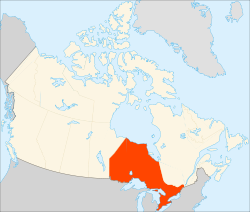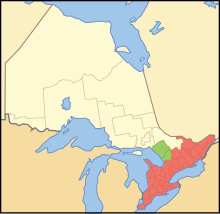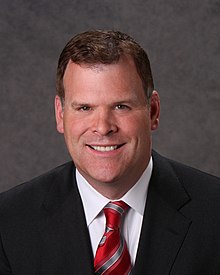The Ontario Portal


Ontario (/ɒnˈtɛərioʊ/ on-TAIR-ee-oh; French: [ɔ̃taʁjo]) is the southernmost province of Canada. Located in Central Canada, Ontario is the country's most populous province. As of the 2021 Canadian census, it is home to 38.5 percent of the country's population, and is the second-largest province by total area (after Quebec). Ontario is Canada's fourth-largest jurisdiction in total area of all the Canadian provinces and territories. It is home to the nation's capital, Ottawa, and its most populous city, Toronto, which is Ontario's provincial capital.
Ontario is bordered by the province of Manitoba to the west, Hudson Bay and James Bay to the north, and Quebec to the east and northeast. To the south, it is bordered by the U.S. states of (from west to east) Minnesota, Michigan, Ohio, Pennsylvania, and New York. Almost all of Ontario's 2,700 km (1,700 mi) border with the United States follows rivers and lakes: from the westerly Lake of the Woods, eastward along the major rivers and lakes of the Great Lakes/Saint Lawrence River drainage system. There is only about 1 km (5⁄8 mi) of actual land border, made up of portages including Height of Land Portage on the Minnesota border.
The great majority of Ontario's population and arable land is in Southern Ontario, and while agriculture remains a significant industry, the region's economy depends highly on manufacturing. In contrast, Northern Ontario is sparsely populated with cold winters and heavy forestation, with mining and forestry making up the region's major industries. (Full article...)
Selected article -
Southern Ontario is a primary region of the Canadian province of Ontario. It is the most densely populated and southernmost region in Canada, with approximately 13.5 million people, approximately 36% of Canada's population of 37 million. The region lies south of the province's other primary region, Northern Ontario, although the exact northern boundary of Southern Ontario is disputed. However, its core region is situated south of Algonquin Park, the latter being in an area of transition between coniferous forest north of the French and Mattawa Rivers and southern deciduous forest. It covers between 14 and 15% of the province, depending on the inclusion of the Parry Sound and Muskoka districts which also lie in the transitional area between northern and southern forest regions. Southern Ontario differs greatly from Northern Ontario, having a much higher population density, a different climate, and a different culture than its northern counterpart. It is broken into smaller subregions, including Central Ontario, Eastern Ontario, the Golden Horseshoe, and Southwestern Ontario.
The core area of Southern Ontario is part of the Quebec City–Windsor Corridor, which extends northeast into southern Quebec. The transitional northern area of this primary region extends north to the Mattawa River and occupies part of the Grenville Geological Province of the Canadian Shield, which also extends northeast into southern Quebec; most of Northern Ontario lies within the Superior Geological Province. (Full article...)General images
Surrounding areas
Selected biography -
John Russell Baird PC (born May 26, 1969) is a retired Canadian politician. He served as Minister of Foreign Affairs from 2011 to 2015 in the cabinet of Prime Minister Stephen Harper. He had been a member of the federal cabinet, in various positions, since 2006. Previously he was a provincial cabinet minister in Ontario during the governments of Premiers Mike Harris and Ernie Eves. Baird resigned from Harper's cabinet on February 3, 2015, and as a Member of Parliament on March 16, 2015.
A long-time resident of the former city of Nepean, where he attended Bell High School, and a graduate of Kingston's Queen's University, he was the member of the House of Commons of Canada for the riding of Ottawa West—Nepean until 2015. Baird was elected there as a candidate for the Conservative Party of Canada in the 2006 federal election, when his party defeated Paul Martin's Liberal Party and established a minority government. Baird was sworn in as Leader of the Government in the House of Commons, replacing Jay Hill, on August 6, 2010. Prior to this, Baird served as Transport Minister starting October 30, 2008, Environment Minister starting January 2007, and President of the Treasury Board during the Conservatives' first year in power. (Full article...)Selected image
Did you know? -
- ... that nearly every person in Val Gagné, Ontario, died in the 1916 Matheson Fire, and the settlement was renamed to honour the heroic efforts of the parish priest?
Related projects and portals
Topics
Categories
Things you can do
- Help expand stub articles: There are numerous stub articles relating to Ontario. You can help by expanding them. See Ontario stubs for a list. Also, for geographical (places) stubs, refer to:
- Eastern Ontario: Eastern Ontario geography stubs
- Toronto: Toronto geography stubs
- Ottawa: Ottawa stubs - All stubs relating to Ottawa in general
- Northern Ontario: Northern Ontario geography stubs
- Western Ontario: Western Ontario geography stubs
- Golden Horseshoe: Golden Horseshoe geography stubs
Associated Wikimedia -
The following Wikimedia Foundation sister projects provide more on this subject:
-
Commons
Free media repository -
Wikibooks
Free textbooks and manuals -
Wikidata
Free knowledge base -
Wikinews
Free-content news -
Wikiquote
Collection of quotations -
Wikisource
Free-content library -
Wikiversity
Free learning tools -
Wikivoyage
Free travel guide -
Wiktionary
Dictionary and thesaurus






































